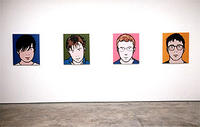
"Almost anything in the National Portrait Gallery is irritating, but this is particularly so because Opie's done such a smoothed out, contemporary, stylish painting without any real originality or feeling or emotion. It's not anything that couldn't have been done on a computer. I know it invites comparisons with Warhol and Richter, but with both of those there are great painterly touches and emotions, but not with Opie."Critiquing a lot of contemporary art, in a public forum like a newspaper, is next to impossible to do without sounding immensely out-of-it. This is because much of the art hanging in galleries around the world is designed to provoke specific responses. And when these complaints are expressed, the rest of us are supposed to snicker because the person taking offense obviously isn't in on the shtick. From my worm's eye view, lots of art world patter is constructed off of repetition of praise, put-downs and buzzwords.
Anyway, Opie's art isn't uniformly bad. I'm interested in his work because he shares a few of the same sources as me: the paintings of Patrick Caulfield, and the interiors and sculptural work of Lichtenstein. (Not that my ideal work looks anything like this.) Opie's stuff works when it is a counterpoint to an actual environment, or, in his early work which referenced the video games of the early '90s, when it is an environment in itself. The key phrase in the Guardian critique is, "It's not anything that couldn't have been done on a computer." Dubuffet's art was engineered to elicit, "A child could do this!" This kind of work is the new Art Brut.
 |  |
Link to Julian Opie's website.

2 comments:
"It's not IF the art pisses you off, it's HOW it pisses you off that matters!"
That said, just looking at his "people" and "portraits", this is the sort of work that only comes off as NOT totally shit when shown in series.
I loath his "portraits," but his "people" are sort of interesting because you can impose any kind of hottie you like on the iconic woman doing a strip tease (as long as she's thin, that is) so the work ends up being personal for the viewer (but then, it's not hard to get a 29 year old guy's attention with sex now, is it?). I also sort of dig the idea of a floating head without a neck which is still, somehow, attached to a body.
I'm 90% positive that his landscapes have all been scanned, vectorized, and fed through the mighty opaque projector. How fresh. How appealing. <---- LIES!
Oh, the landscapes are totally vector traced then projected. That doesn't irk me nearly as much as the little anecdotes inserted beside each landscape about his travels to various locales.
I like the video game references of the bottom two pictures I posted. Particularly the scale shift between the boxy ray-traced car and the buildings, also the idea of putting a horizion on the walls, all around the room, at knee level. But I think the actual pioneering VR he's referencing is a million times cooler than Opie's work.
I think this guy is a good bellwether for what the art world is looking for. That is, the several thousand people who buy and sell paintings. That the work is fluff doesn't concern them nearly as much as setting themselves apart from the proles out on the street.
Post a Comment